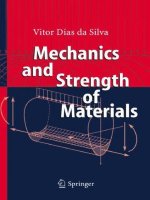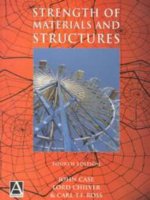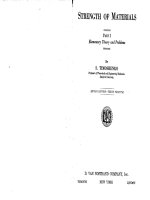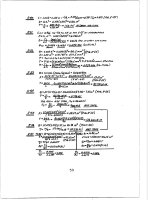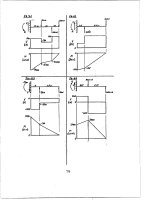Strength of material
Bạn đang xem bản rút gọn của tài liệu. Xem và tải ngay bản đầy đủ của tài liệu tại đây (271.29 KB, 30 trang )
Section 4
Behaviour of Materials
The section will cover the behaviour of materials by introducing the stress-strain curve. The
concepts of elastic and plastic deformation will be covered. This will then lead to a discussion
of the micro-structure of materials and a physical explanation of what is happening to a
polycrystalline material as it is loaded to failure.
© Loughborough University 2010. This work is licensed under a Creative Commons Attribution 2.0 Licence.
Contents
•
Introduction
•
Elasticity
•
Plasticity
•
Elastic-Plastic Stress-Strain Relationship
•
Elastic-Plastic Stress-Strain Curves
•
Secant and Tangent Modulii
•
Unloading Modulus and Plastic Strain
•
True Stress and Strain
•
True Stress-Strain Curve
•
Constant Volume Concept
•
True Stress and Strain Relationships
•
Ductility Index
•
Imperfections in Solids
•
Line Defects or Dislocations
•
Dislocation Movement and Strain Hardening
•
Microscopic Interpretation of Elastic-Plastic Stress-Strain Relationship
•
Hardness
•
Credits & Notices
Introduction
•
Knowledge of a material’s properties, and
how it behaves under various loading
conditions is essential in design
–
Materials are selected for specific applications
dependent on their properties and
characteristics
•
The behaviour of a material under load is
markedly different depending on whether
the material response is elastic or plastic
Elasticity
•
For the tensile bar, the external load has been assumed to
be low enough that the bar will resume its initial shape
once the external load is removed
•
This state of elastic
deformation is possible
only when the external
load is within certain
limits
•
In the elastic range, the
load-displacement or
stress-strain curve is
linear – loading and
unloading follow the
same path
Elastic limit
σ
ε
Loading
Unloading
E
Plasticity
•
If the loading is increased, it will reach a certain limit
whereby elastic deformation would end and plastic
deformation would start
•
This limit is known as the
elastic limit and beyond
this point the material is
said to have yielded
•
The loading is thus
beyond the elastic limit
–
Permanent or irreversible
deformation
•
Stress corresponding to
yielding is called the yield
strength, denoted by σ
y
Elastic limit
σ
ε
Loading
Unloading
E
Point of
yielding
σ
y
Elastic-Plastic Stress-Strain Relationship
•
Linear elastic stress-strain relationship
considered thus far
–
Knowledge of mechanical behaviour in plastic region
also important in structural design / stress analysis
–
Complex plastic behaviour dependent on nature of
material
•
Complete elastic-plastic stress strain relationship
can be categorised by two types:
–
Distinct yielding, i.e. mild steels, low / medium carbon
steels
–
Less distinct yielding, i.e. aluminium alloys, alloy steels
Elastic-Plastic Stress-Strain Curves
Low / Medium Carbon Steels
Aluminium Alloys and Alloy
Steels
σ
ult
= Ultimate Strength
σ
YU
= Upper yield point
σ
YL
= Lower yield point
σ
pr
= Proof stress
σ
ε
0.1%
0.2%
0.1% σ
pr
0.2% σ
pr
σ
ult
Limit of
Proportionality
σ
ε
σ
YU
σ
YL
σ
ult
E
Strain
Hardening
Necking
Secant and Tangent Modulii
•
Some materials (cast iron,
concrete) do not have a
linear elastic portion of the
stress-strain curve
•
For this nonlinear
behaviour, Secant and
Tangent Modulii are used
•
Secant modulus:
–
Slope of straight line
between origin and a
point on stress-strain
curve
•
Tangent modulus:
–
Slope of the stress-strain
curve at a specified level
of stress
σ
ε
σ
1
σ
2
ε∆
σ∆
=
sec
E
ε∆
σ∆
=
tan
E
Unloading Modulus and Plastic Strain
•
Unloading path is often
linear
–
Slope of an approximate
straight unloading line
defined as the unloading
modulus
•
Plastic or permanent
deformation calculated
from knowledge of total
strain
loadingsecunloading
EEE ≈≈
petot
ε+ε=ε
ε
p
ε
e
ε
σ
0.1% σ
pr
E
sec
Example 4.1
•
A steel tensile specimen has a diameter of
10mm and a Young’s modulus of 209GPa.
The load corresponding to 0.2% strain limit
is 7kN and the maximum load recorded is
10kN with a total strain of 10%. Determine
(i) the yield strength, (ii) the ultimate
strength, and (iii) the plastic strain at the
maximum load.
Answer: (i) σ
y
=89 MPa (ii) σ
ult
=127 MPa (iii) ε
p
=9.94%
True Stress and Strain
•
True Stress: a stress defined with respect to the
current or true cross-sectional area, A
true
as
•
In the plastic range, plastic deformation or
permanent reduction in cross-sectional area is
significant
•
A continuous use of nominal or engineering
stress is no longer accurate
true
x
true
A
P
=σ
True Stress-Strain Curve
ε
σ
Onset of necking
True Stress-Strain Curve
Corrected for complex stress
state in the neck region
Engineering Stress-Strain Curve
A
true
P
x
P
x
P
x
P
x
A


